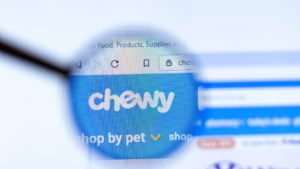Recent weeks have seen volatility and nervousness in many of the growth darlings of Wall Street. In fact, the Nasdaq 100 index, which hit an all-time high in mid-February, is about flat for 2021. Many analysts point out frothy valuations in a large number of these names mean the potential for multiples to compress. Given the early signs of a pullback, today’s article introduces seven in growth stocks that deserve to be on your radar.
Recent research led by Federico Gagliolo of University of Genoa highlights, “since the burst of the financial crisis in 2008 … growth stocks have outperformed value stocks, a situation that has never occurred for such a long period of time.” Following the lows hit in March 2020, growth shares have reached record highs.
The choice of a portfolio style is an important investment decision. Proponents of growth investing say that well-run firms with above-average growth rates can help achieve superior returns. T. Rowe Price has especially emphasized the importance of having growth stocks in long-term portfolios. The market’s challenge generally lies with how to correctly value a young or small firm that may not even be profitable.
On the other end of the spectrum, we find value stocks. They come with cheaper prices as they might have fallen out of favor in recent quarters due to poor investor sentiment. Such businesses tend to have current valuation levels that are considerably lower than their historical averages. Low valuation levels understandably mean a sense margin of safety for portfolios. Benjamin Graham and Warren Buffett are among the most-respected value investors.
Most financial planners would concur that a long-term portfolio would benefit from exposure to growth names. Here are seven growth stocks with compelling stories:
- Catalent (NYSE:CTLT)
- Chewy (NYSE:CHWY)
- ETFMG Prime Cyber Security ETF (NYSEARCA:HACK)
- Innovator Loup Frontier Tech ETF (NYSEARCA:LOUP)
- Oracle (NYSE:ORCL)
- Pool (NASDAQ:POOL)
- Salesforce.com (NYSE:CRM)
Growth Stocks: Catalent (CTLT)

Somerset, New Jersey-based drug manufacturer Catalent works with other biopharma companies to develop and manufacture biologics, which are synthesized from living biological organisms, gene therapies, and consumer health products.
The contract manufacturer has around 7,000 customers. Its operations are worldwide and in FY 2020, annual revenue was more than $3 billion.
Catalent released FY21 Q2 results in early February. Net revenue was $910.8 million, up 26% year-over-year (YoY). Adjusted net income came at $114.4 million, an increase of 59% YoY. Diluted adjusted net income was 63 cents, increasing 40% YoY. Cash and equivalents by the end of Q2 were $833.1 million, up 441% YoY.
“Our second quarter results reflect robust organic growth in our Biologics segment, and our increased guidance reflects our expectation of continued strong results for these offerings for the remainder of our fiscal year,” CEO John Chiminski said. “Additional capacity in our drug product and drug substance offerings will come on line in the second half of our fiscal year to help fight the pandemic and serve other critical patient needs.”
Following the release of these metrics, CTLT stock hit record highs. Investors have been pleased that Catalent has been working with AstraZeneca PLC (NASDAQ:AZN), Johnson & Johnson (NYSE:JNJ), Moderna (NASDAQ:MRNA), on novel coronavirus vaccine efforts. The current forward P/E and P/S ratios are 32.05 and 4.96, respectively. A potential decline below the $100 level would improve the margin of safety.
Chewy (CHWY)

Dania Beach, Florida-headquartered Chewy is a well-known e-commerce leader, selling pet products, supplies and prescriptions. It offers more than 2,000 brands and 45,000 items, including its own brands and prescription products. Covid-19 has meant increased online sales across many product categories, including pet items. And management has executed well, capitalizing on these macro trends.
According to recent quarterly numbers, net sales of $1.78 billion grew 45% YoY. Net loss of $32.9 million was an improvement of 58.4% from the loss of $79 million same period prior year. Adjusted net loss per share was 8 cents. A year ago it was 20 cents. Free cash flow was $32.9 million, increasing $45.7 million from last year.
“Over the past few quarters, our team has been hard at work to reformat our proprietary brands and overall assortment strategy by introducing compelling merchandise, improving discoverability, and delivering a tremendous value proposition for our customers,” CEO Sumit Singh said. “We are also proud to take a leading role in making pet healthcare more affordable and accessible with the recent expansion of our healthcare offerings to include medicinal compounding and telehealth.”
CHWY stock’s P/S ratio is 5.36. The end of the pandemic might mean a decline in online sales for Chewy as well as other businesses. Therefore, shares of the pet e-commerce group are likely to take a breather in the coming weeks. However, most individuals will likely continue to pay attention to their pets, whom they regard as a member of their of families. Thus, the long-term secular trend of increases sales should stay intact.
Potential investors could regard a decline below $80 as a better point of entry.
ETFMG Prime Cyber Security ETF

My next choice is an exchange-traded fund, the ETFMG Prime Cyber Security ETF. The fund gives access to global cybersecurity firms that typically provide, software, hardware and consulting services. More than 75% of the companies in ETF are U.S.-based. Next in line are firms from Israel (7.3%), UK (3.9%), and Japan (3.6%).
The Cybersecurity and Infrastructure Security Agency (CISA) has recently warned of cybersecurity “compromises of U.S. government agencies, critical infrastructure entities, and private sector organizations by an advanced persistent threat (APT) actor beginning in at least March 2020.” President Joe Biden has also said ensuring cybersecurity will be a top priority of his administration.
HACK tracks the Prime Cyber Defense Index. Since the ETF’s inception in November 2014, assets have reached $2.1 billion. In terms of allocation, systems software leads with 57.8%. Next are information technology consulting and other services (10.8%), application software (9.1%) and communications equipment (8.6%).
The top 10 names comprise close to 30% of the fund. Canadian enterprise security software company BlackBerry (NYSE:BB); tech giant Cisco (NASDAQ:CSCO), and network security group Fortinet (NASDAQ:FTNT) lead the names on the roster.
Over the 12 months, the fund is up more than 75% and hit a record high in late January. A potential decline below $55 would mean a better entry point for buy-and-hold investors. The diversified nature of the ETF with 60 holdings means potentially less volatility than holding individual names in portfolios.
The fund’s dividend yield is about 1.11% and its expense ratio is 0.60% per year.
Growth Stocks: Innovator Loup Frontier Tech ETF

Out next discussion centers around another thematic fund, one that focuses on innovation in the tech space. The Innovator Loup Frontier Tech ETF gives access to firms at the forefront of the developments in artificial intelligence, autonomous vehicles, robotics and virtual reality. It began trading in July 2018 and has about $42 million in assets. In other words, it is still a relatively small fund.
LOUP, which tracks the Loup Frontier Tech Index, has 30 holdings. More than half of the stocks come from the U.S.. Next in line are China (12.11%), Japan (11.53%) and the UK (3.24%). Information technology (65.05%), industrials (16.49%), consumer discretionary (13.55%), and communication services (4.92%) are the sectors in the ETF.
More than 40% of the fund is in the top 10 stocks. Holdings include Chinese Internet search provider Baidu (NASDAQ:BIDU), whose focus on AI has been increasing. Others are Japan-based Yaskawa Electric (OTCMKTS:YASKY) and China-based operator of Huya (NYSE:HUYA), which operates live streaming game platforms.
LOUP has returned more than 15% since the start of the year and hit an all-time high in mid-February. Those investors who want global exposure might consider buying the dips in the fund. Investing in innovation could help fuel most long-term portfolios. A potential decline below $55 would make the fund more attractive from a risk/return profile.
The fund’s expense ratio is about 0.7%.
Oracle (ORCL)

Redwood City, California-headquartered Oracle offers enterprise products, such as cloud and on-remises applications, infrastructure software and hardware, as well as database technology products and services. Founded in 1977, the company owns thousands of patents worldwide. It enjoys pricing power and stable margins in its core software market.
Oracle released FY21 Q3 metrics on March 10. Total quarterly revenues were $10.1 billion, up 3% YoY. Non-GAAP net income was up 10% reaching $3.5 billion. Non-GAAP EPS was $1.16, an increase of 20% YoY. Free cash flow in Q3 was $12.8 billion, up 3% YoY.
“We continued to extend our huge lead in the cloud ERP market as Fusion ERP grew 30% and NetSuite ERP grew 24% in Q3,” CEO Safra Catz said.
Following the release of the earnings, investors decided to hit the sell button. ORCL stock’s forward P/E and P/S ratios are 15.21 and 5.26, respectively. Potential investors might regard the recent decline as a good opportunity to buy into the share price of the enterprise software company. I expect Oracle’s cloud-based turnaround efforts to pay off significantly in the coming quarters.
The company is also well-known for its stock buybacks and stable dividends, which might be due for a hike.
Pool (POOL)

Covington, Louisiana-based Pool is the world’s largest wholesale distributor of swimming pool and related outdoor living products. It operates in North America, Europe and Australia. Over the years, the group has grown both organically and through acquisitions. The stay-at-home economy of the past year put the limelight on home improvements. Pool was one of the beneficiaries.
Management released Q4 and full year results on Feb. 11. Net sales increased 44% to $839 million. Total net sales for FY20 increased 23% to a record high of $3.9 billion. Net income for the quarter was $59 million, up 328% YoY. Diluted EPS was 1.45, an increase of 330% YoY. Cash and equivalents at the end of FY20 stood at $34.1 million, up 19.4%.
“As the pandemic forced families to spend more time at home in 2020, they sought out opportunities to create or expand existing home-based outdoor living and entertainment spaces,” CEO Peter D. Arvan said. “This created unprecedented demand throughout our markets. Our scale and execution, combined with favorable weather conditions, drove truly remarkable results for the year, including an exceptionally strong fourth quarter.”
POOL stock’s trailing P/E, P/S and P/B ratios are 38.10, 3.55 and 21.54, respectively, pointing to a historically rich valuation level. Therefore, a pull-back toward $325 is likely.
But pools need constant maintenance, meaning a relatively predictable business model and recurring cash flows for the company. Therefore, long term, I’m bullish on the shares.
Growth Stocks: Salesforce.com (CRM)

San Francisco, California-headquartered Salesforce.com provides customer relationship management (CRM) enterprise products. Its platform includes marketing and sales force automation, customer service and support, digital commerce, analytics and collaborative productivity tools. In other words, it is comprehensive. To the delight of long-term shareholders, the past decade has seen the company grow rapidly.
Management released Q4 rand full-year results in late February. For FY21, revenue came at $21.25 billion, up 24% YoY. Fourth-quarter revenue of $5.82 billion meant an increase of 20% YoY. Quarterly non-GAAP diluted earnings per share was $1.04. Cash generated from operations for Q4 was $2.17 billion, an increase of 33% YoY. Total cash and equivalents came at $11.97 billion.
“We had a record quarter and year by innovating more and faster than ever, enabling our customers to be successful from anywhere, and becoming more relevant and strategic than ever,” CEO Marc Benioff said.
CRM stock’s forward P/E and P/S ratios are 62.11 and 9.29, pointing to a frothy valuation level. Potential investors would find better value between $190 and $200. In the long run, the cloud-based CRM software provider is likely to create significant shareholder value.
On the date of publication, Tezcan Gecgil did not have (either directly or indirectly) any positions in the securities mentioned in this article.
Tezcan Gecgil has worked in investment management for over two decades in the U.S. and U.K. In addition to formal higher education in the field, she has also completed all 3 levels of the Chartered Market Technician (CMT) examination. Her passion is for options trading based on technical analysis of fundamentally strong companies. She especially enjoys setting up weekly covered calls for income generation.
